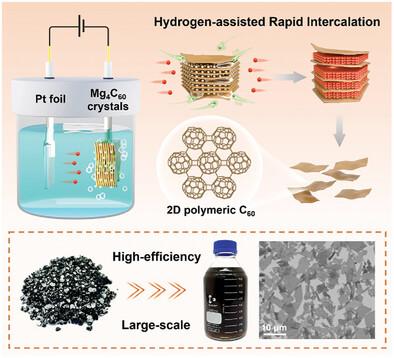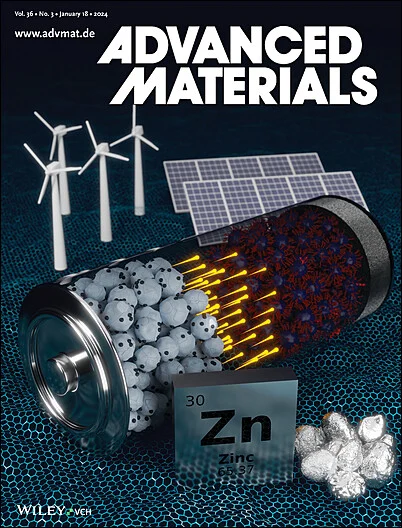Electrochemical Synthesis of 2D Polymeric Fullerene for Broadband Photodetection
IF 27.4
1区 材料科学
Q1 CHEMISTRY, MULTIDISCIPLINARY
引用次数: 0
Abstract
2D polymeric fullerene scaffolds, composed of covalently bonded superatomic C60 nanoclusters, are emerging semiconductors possessing unique hierarchical electronic structures. Hitherto their synthesis has relied on complex and time-consuming reactions, thereby hindering scalable production and limiting the technological relevance. Here, the study demonstrates a facile electrochemical exfoliation strategy based on the intercalation and expansion of a layered fullerene superlattice, to produce large size (≈52.5 µm2) and monolayer thick 2D polymeric C60 with high exfoliation yield (≈83%). In situ reduction of solvated protons (H+) weakens the interlayer interactions thereby promoting the rapid and uniform intercalation of tetra-n-butylammonium (TBA+), ensuring gram-scale throughput and high structural integrity of exfoliated 2D polymeric C60. As a proof of concept, the solution-processed 2D polymeric C60 nanosheets have been integrated into thin-film photodetectors, exhibiting a broad spectral photoresponse ranging from 405 to 1200 nm, with a peak photocurrent at 850 nm and a stable response time. This efficient and scalable exfoliation method holds great promise for the advancement of multifunctional composites and optoelectronic devices based on 2D polymeric C60.

求助全文
约1分钟内获得全文
求助全文
来源期刊

Advanced Materials
工程技术-材料科学:综合
CiteScore
43.00
自引率
4.10%
发文量
2182
审稿时长
2 months
期刊介绍:
Advanced Materials, one of the world's most prestigious journals and the foundation of the Advanced portfolio, is the home of choice for best-in-class materials science for more than 30 years. Following this fast-growing and interdisciplinary field, we are considering and publishing the most important discoveries on any and all materials from materials scientists, chemists, physicists, engineers as well as health and life scientists and bringing you the latest results and trends in modern materials-related research every week.
 求助内容:
求助内容: 应助结果提醒方式:
应助结果提醒方式:


